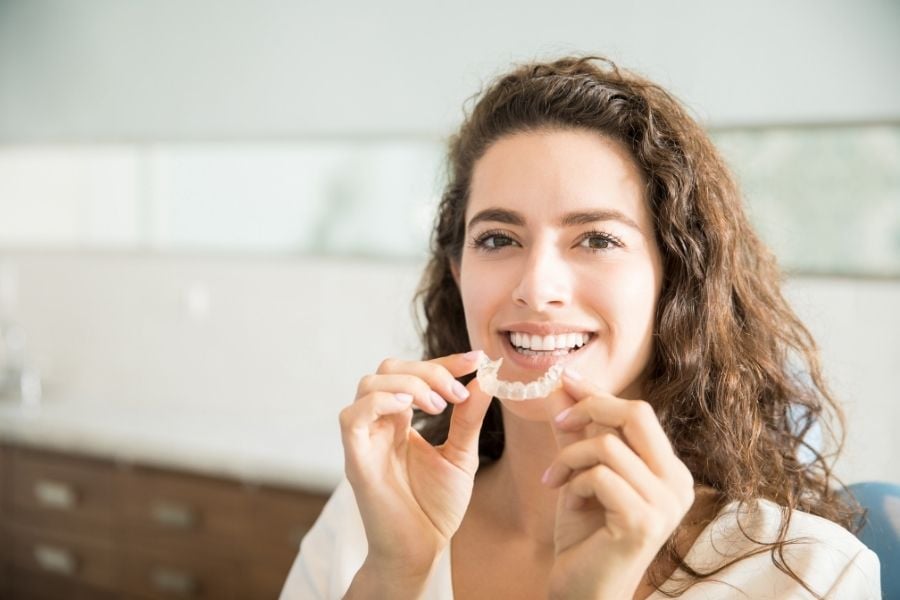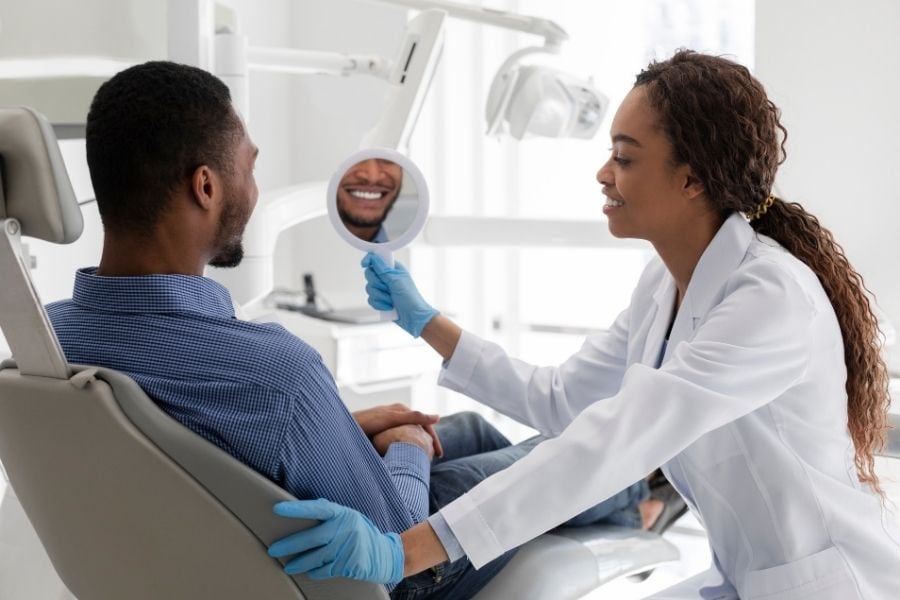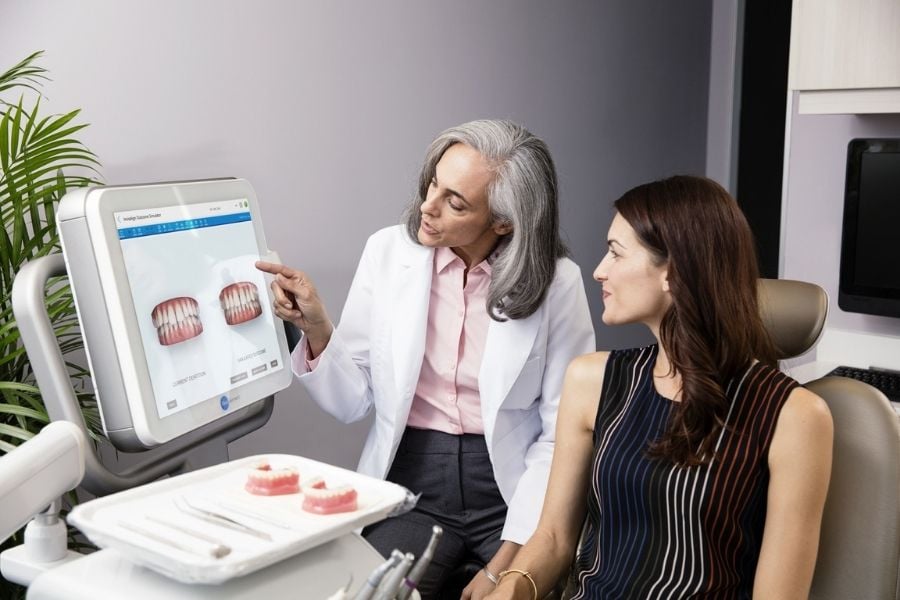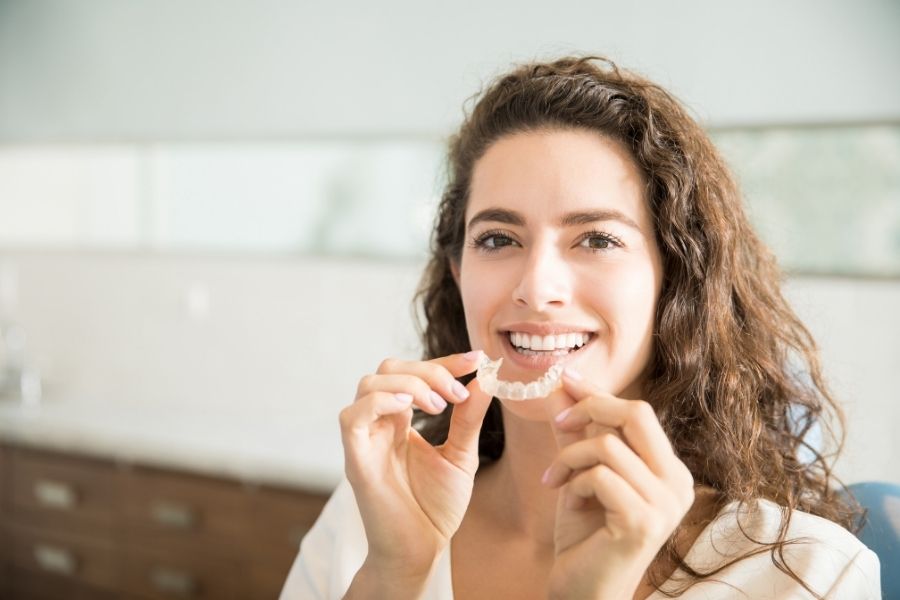
Nothing makes a lasting first impression than a nice smile. That’s especially true for those of us who are active on social media, especially Instagram.
Braces are fast becoming a thing of the past, fortunately, for patients in need of correcting their teeth. Ideally, particularly from a cosmetic perspective, you’ll want to speak with your dentist about an orthodontic solution that is less noticeable than a mouthful of metal.
What is Invisalign?
Invisalign® treatment, according to Dr. Sunny Gill, HealthOne’s Dental Director, is the latest and greatest technology to straighten teeth and improve our smiles. Say goodbye to that mouthful of metal, and hello to clear, plastic aligners that are custom-fit to treat patient cases like crowding teeth, crossbite, overbite, underbite, gapped teeth, or generally teeth that just need straightening. There are many different bites that Invisalign can fix, which we outlined in a previous blog. “They are virtually invisible,” he says.
Dr. Gill adds the timeline for treatment also isn’t as arduous as the old days. The period from initial consultation to a better smile has been shortened considerably. That’s because of the Invisalign technology, which is constantly evolving.
The aligners are strong enough to slowly move your teeth gently over time, “a series of small incremental, .1 or .2 mm, movements,” he says. The experience the HealthOne team has working with Invisalign® treatment, plus the custom digital-based plan that every patient receives, also contribute to faster treatment time.
You’d typically be looking at 24-30 months with conventional braces. Dr. Gill has been working with Invisalign® treatment for eight years, and says with most cases the treatment time is boiled down to six months. His patients range in age from 16 to 73, and that should tell you a lot.
For many of us, braces were something you wore during your high school years. Nobody wanted them in their 20s, especially for cosmetic reasons, as people entered the workforce. Perhaps you have an important life event coming up, like a wedding, and you want a better smile for those family photos? Or as Dr. Gill says, you need to straighten your teeth because it’s tougher to clean them if they are left as they are, leading to cavities and gum disease, or worse. Oral hygiene should always be a priority!
His 73-year-old patient signed on for the Invisalign® treatment because her teeth were unhealthy and constantly in need of repair, along with the added cost and discomfort that came with that. So, what does the experience look like from start to finish?

What are the steps?
The first thing the HealthOne team needs to determine is if the patient is a good candidate for the Invisalign® treatment. “It’s an amazing treatment option, but it’s not a silver bullet for everyone,” Dr. Gill says.
Some patients might have certain types of skeletal problems that would make it difficult to get good results from. The good news is by far the vast majority of patients that come in end up being good candidates.
So the clinical consultation comes first, which can be easily booked online. The doctor gets to better understand the patient’s objectives, what they want to achieve. They get a better understanding of when the patient wants to have it done by.
In that consultation, the team will begin to put together orthodontic records–take some pictures of the teeth, and the smile, and understand how the teeth fit together.
They’ll take x-rays to get a sense of gum health, and to make sure the bone health beneath the teeth is good. “You don’t want to start moving the teeth around if the bones are not healthy,” he says.
They will also take a digital scan, and this is where a wonderful piece of technology called iTero Element comes into play. This is a digital scanner that creates a 3D image of your teeth and smile–hence the end of that archaic alginate treatment (even if they do offer you different flavours!).
“This technology has revolutionized a digital workflow for us, in the past few years,” says Dr. Gill. In just under five minutes, the doctor has an exceptionally accurate scan in his or her hands. So a plan on how to move the teeth can then be put into place. It’s changed the game, he adds. The technology provides a permanent digital record the HealthOne team can keep coming back to.

The second step is a treatment plan, which will take two-four weeks. Dr. Gill says he likes to take his time with this process, and there’s a good reason for that. Having a good plan directly impacts the length of treatment time.
“We are getting really good at reducing patient treatment times compared to what most people are doing,” he says. “We know where the teeth are supposed to go, to be in the right physical position, for the functionality of the bite. It’s not just about making the teeth straight. It’s also about making sure they fit and function well.”
Invisalign Attachments
Once the planning process is done, the trays are manufactured, shipped over to HealthOne, and the patient is ready to start. They go over the treatment plan with the patient. Then they’ll place the attachments–little dots or anchors that go on the teeth to anchor the clear plastic tray.
There might be some polishing of the teeth to create space. The professionals will make sure all the teeth fit within the arch. The tray is then inserted into the mouth, making sure it fits nicely. The patient will be instructed how and when to take it on and off (when eating and when they brush their teeth). The patient will then be sent home with a series of trays.
Every four to 12 weeks, depending on the patient, they’ll come back to the office for a checkup, and a re-adjustment if need be, to make sure the process is on schedule, until the end of treatment.
The Post-treatment phase
Once a patient comes in for their final appointment, the dentist will check to make sure the desired results have been achieved. In some cases, patients may require additional trays beyond their original treatment plan to get their new smile just right.
At the end of the process, the HealthOne team will remove those little attachments, clean and polish the teeth, and digitally scan the patient for a retainer. The patient will wear that at night time to maintain the position of the teeth.
“We recommend they wear that retainer for a minimum of two years,” Dr. Gill says. This is an important step to maintain the beautiful smile you waited so long to reveal!
Invisalign Cost
A big factor that people wonder about is how much Invisalign will cost them. It's an important thing to consider when looking at the pros and cons of different treatments. Dr. Gill says they make a point of prioritizing a payment plan for every individual based on their financial reality.

Factors that determine cost include the amount of work needed to shift your teeth, the number of dental visits required, and how much your insurance plan covers orthodontics. Some HealthOne patients, for example, will pay $120 per month, over 48-, 36- and 24-month periods. We covered more details about our payment options on our Invisalign service page.
Patients get confused, Dr. Gill adds. They think of Invisalign® as a product, as opposed to a tool. Like any tool, the success depends on who is using it, and that’s where the HealthOne team comes in.
Invisalign Toronto
The Invisalign® Advantage Program has recognized the HealthOne dental clinic and Dr. Gill as a Diamond Provider, meaning they are in the top one per cent of Invisalign providers in North America. That’s a testament to the success and popularity of the program, the skill level of the professionals who use it.
“Our philosophy is that we’re the right fit for people who are looking to improve their smile using a leading-edge cosmetic orthodontic option in the fastest way possible,” he says. “We think having straight and beautiful teeth allow people to have a confident smile. That makes everything healthier in the mouth overall, and that makes people happier.”
Visit HealthOne Dental Clinic Toronto now or book your complimentary consultation for Invisalign® treatment today!



